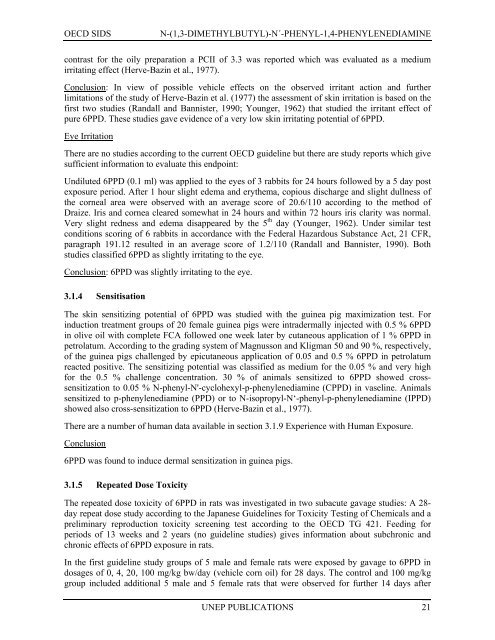N-(1,3-Dimethylbutyl)-N
N-(1,3-Dimethylbutyl)-N
N-(1,3-Dimethylbutyl)-N
You also want an ePaper? Increase the reach of your titles
YUMPU automatically turns print PDFs into web optimized ePapers that Google loves.
OECD SIDS<br />
N-(1,3-DIMETHYLBUTYL)-N´-PHENYL-1,4-PHENYLENEDIAMINE<br />
contrast for the oily preparation a PCII of 3.3 was reported which was evaluated as a medium<br />
irritating effect (Herve-Bazin et al., 1977).<br />
Conclusion: In view of possible vehicle effects on the observed irritant action and further<br />
limitations of the study of Herve-Bazin et al. (1977) the assessment of skin irritation is based on the<br />
first two studies (Randall and Bannister, 1990; Younger, 1962) that studied the irritant effect of<br />
pure 6PPD. These studies gave evidence of a very low skin irritating potential of 6PPD.<br />
Eye Irritation<br />
There are no studies according to the current OECD guideline but there are study reports which give<br />
sufficient information to evaluate this endpoint:<br />
Undiluted 6PPD (0.1 ml) was applied to the eyes of 3 rabbits for 24 hours followed by a 5 day post<br />
exposure period. After 1 hour slight edema and erythema, copious discharge and slight dullness of<br />
the corneal area were observed with an average score of 20.6/110 according to the method of<br />
Draize. Iris and cornea cleared somewhat in 24 hours and within 72 hours iris clarity was normal.<br />
Very slight redness and edema disappeared by the 5 th day (Younger, 1962). Under similar test<br />
conditions scoring of 6 rabbits in accordance with the Federal Hazardous Substance Act, 21 CFR,<br />
paragraph 191.12 resulted in an average score of 1.2/110 (Randall and Bannister, 1990). Both<br />
studies classified 6PPD as slightly irritating to the eye.<br />
Conclusion: 6PPD was slightly irritating to the eye.<br />
3.1.4 Sensitisation<br />
The skin sensitizing potential of 6PPD was studied with the guinea pig maximization test. For<br />
induction treatment groups of 20 female guinea pigs were intradermally injected with 0.5 % 6PPD<br />
in olive oil with complete FCA followed one week later by cutaneous application of 1 % 6PPD in<br />
petrolatum. According to the grading system of Magnusson and Kligman 50 and 90 %, respectively,<br />
of the guinea pigs challenged by epicutaneous application of 0.05 and 0.5 % 6PPD in petrolatum<br />
reacted positive. The sensitizing potential was classified as medium for the 0.05 % and very high<br />
for the 0.5 % challenge concentration. 30 % of animals sensitized to 6PPD showed crosssensitization<br />
to 0.05 % N-phenyl-N'-cyclohexyl-p-phenylenediamine (CPPD) in vaseline. Animals<br />
sensitized to p-phenylenediamine (PPD) or to N-isopropyl-N‘-phenyl-p-phenylenediamine (IPPD)<br />
showed also cross-sensitization to 6PPD (Herve-Bazin et al., 1977).<br />
There are a number of human data available in section 3.1.9 Experience with Human Exposure.<br />
Conclusion<br />
6PPD was found to induce dermal sensitization in guinea pigs.<br />
3.1.5 Repeated Dose Toxicity<br />
The repeated dose toxicity of 6PPD in rats was investigated in two subacute gavage studies: A 28-<br />
day repeat dose study according to the Japanese Guidelines for Toxicity Testing of Chemicals and a<br />
preliminary reproduction toxicity screening test according to the OECD TG 421. Feeding for<br />
periods of 13 weeks and 2 years (no guideline studies) gives information about subchronic and<br />
chronic effects of 6PPD exposure in rats.<br />
In the first guideline study groups of 5 male and female rats were exposed by gavage to 6PPD in<br />
dosages of 0, 4, 20, 100 mg/kg bw/day (vehicle corn oil) for 28 days. The control and 100 mg/kg<br />
group included additional 5 male and 5 female rats that were observed for further 14 days after<br />
UNEP PUBLICATIONS 21
















